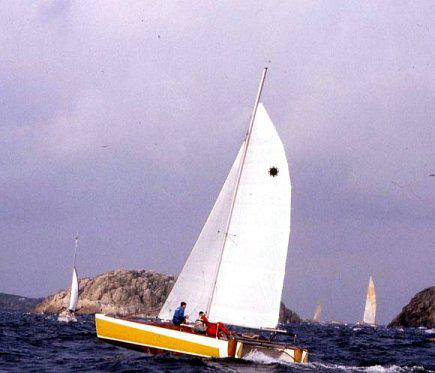Materials

Strip planked hulls
This is a wooden boat but not in the traditional planks on frames sense. Scarlattikvarten was built using the strip planking technique. Strip planking is part wooden boat building and part sandwich composite boat building. The 8 mm thick strips form the core of the sandwich but also take the longitudinal loads. The wood is covered inside and out with a glass/epoxy laminate. The glass is unidirectional with the fibres at right angle to the grain of the wood.
Cold moulded decks
The decks are laminated from 3 mm plywood, 4 mm obeche veneer and 1.5 mm mahogany veneer. The transoms are laminated from 3 mm plywood. Bulkheads and part of the cockpits are made from 6 mm mahogany plywood. The bunks and the cockpit floors are sandwich panels.
Birch/Spruce beams
The present cross-beams are torsionally stiff box beams constructed from 6 mm thick birch plywood, spruce, glass-fibre, and epoxy. In 1989 they replaced the original aluminium beams that had proven them self inadequate. A composite dolphin striker supported the mast until 2004 when I replaced it with beefed up laminates to make the beam more practical at the mooring and on the trailer.
Carbon/Glass/Wood foils
Daggerboards and rudder blades are glass/epoxy structures with some unidirectional carbon in the daggerboards. There is a lightweight timber spar running down the middle of each foil. The task of this spar is to take care of shear forces and sideways compression. Normal density foams are not up to this job.
'Low-tech' rig and mixed-tech sails
The mast is a light-weight aluminium extrusion, and it is supported by stainless steel wires – the most standard solution possible in other words. The sails also used to be of low to medium tech materials. In later years I have, however, fallen for the high-tech temptation and the latest main is of a carbon/Mylar laminate and the latest jib is one of those machine-built rather than sewn sails. The spinnaker is still made from good old nylon.